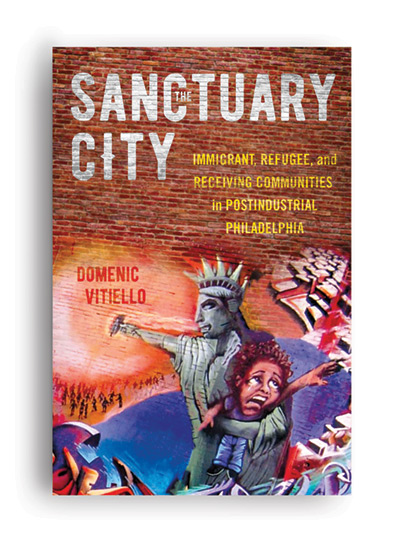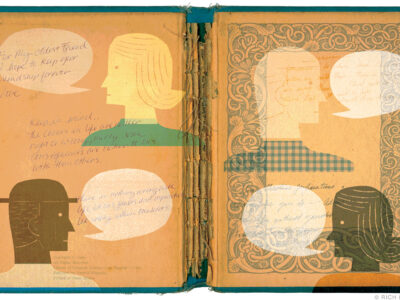How Philadelphia has repelled, attracted, and been reinvigorated by refugees.
By Joel Millman

Receiving Communities in Postindustrial Philadelphia By Domenic Vitiello GFA’98 Gr’04
Cornell University Press, $26.95
Many Americans see immigration policy as a puzzle—one that gets harder to solve with each generation. Domenic Vitiello GFA’98 Gr’04 acknowledges the challenge. Yet he sees not a puzzle but a mosaic: the pieces are all there, but it takes work and creativity to make them fit. And that’s what he does.
Vitiello, an associate professor of city planning and urban studies at Penn’s Weitzman School of Design, counts his commitment to Philadelphia’s renewal as a lifelong pursuit.
“I like to joke that my parents were the only people crazy enough to move to Philadelphia in 1974, when I was one year old,” he writes in the introduction to his newest book, The Sanctuary City: Immigrant, Refugee, and Receiving Communities in Postindustrial Philadelphia. Philadelphia lost more than a quarter of a million residents in the 1970s amid deindustrialization and white flight. But the Vitiello family was moving in the opposite direction.
His father was on the faculty at Temple University and his mother worked for a large hospital—encapsulating the city’s emerging “eds and meds” formula for the postindustrial future. The younger Vitiello traced a similar track, tapping into the city’s education sector—and especially Penn—as a force for welcoming newcomers into the urban core.
Since joining the University as a lecturer in the mid-2000s, Vitiello has focused on the dynamics of urban recovery. In courses with names like “The Immigrant City” and “Metropolitan Food Systems,” he weaves Philadelphia history in and out of contemporary global trends.
And as this book occasionally recounts, he also turns his students loose to probe cities’ shortcomings in integrating newcomers—and discover ways to correct them.
In 2008, for instance, graduate students in his Community and Economic Development Practicum (part of the Master of City Planning program) were asked to examine why refugees from Southeast Asia who’d resettled in South Philly seemed to be doing poorly. This community suffered endless indicators of dislocation: bitter ethnic violence, inadequate job prospects, and the practical difficulty of integrating people from remote jungle farming societies into a bustling US city.
The search for answers led Vitiello’s class to a two-sided story rooted in housing choices. Many of these families lived amidst peeling lead paint in overcrowded apartments that occasionally “lacked heat, hot water, and in some units, even locks on the doors.” Furthermore, these conditions had in many cases persisted for decades—exerting a multi-generational drag on families who had begun arriving after the fall of Saigon in 1975.
Yet this sorry situation masked a more complicated dynamic. After canvassing residents and landlords, the students determined that Hmong and Cambodian refugees were consistently being preyed upon by South Philly slumlords. Victims responded in one of two ways. Some suffered in silence, getting stuck in Philadelphia and falling further behind. But the most capable refugees fled the city for other US destinations. In effect, South Philadelphia’s rental market was repelling the very residents most likely to contribute to the city’s economic vitality.
Vitiello’s students’ rental analysis was presented to one of the principal refugee resettlement agencies, HIAS Pennsylvania, which quickly incorporated the findings into their support programs.
Something similar occurred with another iteration of that practicum class, this time involving the quest of Mexican immigrants to commercialize a flour milled from the kernels of indigenous blue corn called pinole. Vitiello and his students worked with Mexicanos Juntos, a Philadelphia community organization co-founded by another student, Peter Bloom C’05 CGS’05.
Bloom and Vitiello recruited Penn students to identify and interview potential customers for imported pinole, from high-end restaurants in Center City to cafes, bakeries, and specialty grocery stores patronized by immigrants. Vitiello also traveled to Puebla, Mexico, for project development work in the villages where the pinole was produced—returning with duffel bags full of flour to help market the ingredient to chefs and bakers. Though the project ultimately had a bigger impact for Mexican producers than Philadelphia consumers, pinole remains on some Philly restaurant menus, including Blue Corn restaurant on South 9th Street—the Italian Market corridor reinvigorated in recent years by Mexican and Central American entrepreneurs.
Vitiello has also worked with the African Cultural Alliance of North America (ACANA), a community organization for West African immigrants. Philadelphia is home to the country’s largest concentration of refugees from the late-20th-century civil wars in Liberia and Sierra Leone, which spilled over into neighboring Guinea, Mali, and Côte d’Ivoire. In the early 2000s ACANA asked Vitiello to help map the renewal of the city’s main African business corridor, a stretch of Woodland Avenue in Southwest Philadelphia.
He eventually joined ACANA’s board of directors, and by 2019 he and several students had developed a wide-ranging mapping effort to identify all of Philadelphia’s African arrivals who had become homeowners. Today it includes over 11,000 entries of properties bought, rehabilitated, and occupied by African immigrants.
“Property ownership is one of the most important ways that residents invest in their neighborhoods, build community, and accumulate wealth,” he and his colleagues explained in a 2020 paper. The research helped ACANA in 2021 win a $1 million grant from the City of Philadelphia and the United Way.
The Sanctuary City offers a comprehensive retelling of Philadelphia’s resettlement saga from Vitiello’s own childhood all the way into the present. It features deep, detailed narratives of men and women like the Guatemalan identified as Joel Morales, who escaped death squads after organizing sugar cane workers in the 1970s, and Debbie Wei, a Philadelphia high school teacher who in the 1980s organized victims of landlord abuse in West Philadelphia.
Readers also meet figures like John Jallah, who began his trek to Philadelphia as an unpaid servant sent from a Liberian village to serve a “sponsor’s” family in exchange for going to school in the capital. Jallah later rose in the state bureaucracy before becoming a refugee during a Liberian civil conflict. Then there’s Mohammed Al Juboori, whose passage to Philadelphia began in 2003, when the 16-year-old’s family fled Iraq’s Al Anbar province.
In its attention to detail and the intricate shifts in US refugee resettlement policy—including tweaks that favor some newcomers while punishing others, in what looks like systemic racism—The Sanctuary City leaves no nuance unexplored. At times this gives the book the feel of what journalists call a “notebook dump.” But immigration scholars may appreciate Vitiello’s thoroughness.
All audiences stand to gain from a perspective that treats immigration and asylum not merely as a “problem” to be solved, but as a multi-dimensional tapestry of challenges and opportunities.
Vitiello notes, for instance, that Philadelphia’s population dropped by an average of nearly 20,000 residents per year between 1970 and 1990. The flight had much to do with the hemorrhaging of jobs in manufacturing, food packaging, and subsidiary industries.
But the steady draining of population had a silver lining: it left intact an enormous inventory of single-family homes in West Philadelphia. That’s the housing supply that has in more recent years been discovered by African refugees initially resettled in places like New York City and suburban Washington, DC. Thus, even as Hmong and Cambodians fled Philadelphia for opportunities elsewhere, Vitiello explains that a wave of Guineans, Liberians, Nigerians, and Ghanaians rolled in to acquire and occupy those homes. Ukrainians, Iraqis, and refugees from Afghanistan also enjoy a growing presence.
“Those who came in the 1970s and 1980s settled in a city that was declining, while those arriving in the 21st century found improved housing, neighborhoods, and sometimes work conditions and opportunities in a revitalizing city,” his book concludes. “The protection and support of the most vulnerable among us offers a chance to save not just some ‘other people,’ but also ourselves.”
That’s the cycle, and the mosaic, of Philadelphia’s immigrant sanctuary.




